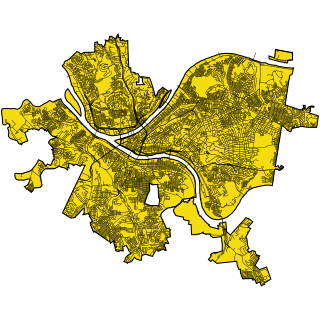Source:Four-corners-northwest
Douglas Naylor. "The four corners of Pittsburgh: Irish bachelor works all day—yet does nothing: Lives on 'top' of city watching over reservoir—decorates his tower home as 'art gallery' with rotogravure pictures of old masters he admires." Pittsburgh Press, Apr. 14, 1932, p. 19. Newspapers.com 146920285.
There's no need for Pittsburghers to go to far places of the world to find strange and interesting facts and stories. They can find them in the Four Corners of their own home town. This is a story of the Northwest Corner, the last of a series.
AN IRISH bachelor lives on the "top" of Pittsburgh. He works all day and yet does virtually nothing.
His name is James Holmes and he is a watchman at the Brashear Reservoir, in the Northwest corner.
The reservoir is 1,376 feet above sea level, 113 feet above the Herron Hill reservoir, the second highest elevation and the one commonly credited with being the highest in Pittsburgh.
Holmes leads an odd life. He's a ruddy-faced Irishman who spends spring days sitting on the edge of the reservoir smoking a pipe and looking down on the city. The old folks never left Ireland, but he and five other children came to the new country. Holmes located in Pittsburgh 37 years ago.
For 13 years he has lived on the top of the city, first as a watchman of the Green tree tanks first built on the hill and later as an employe of the reservoir.
∗ ∗ ∗
HOLMES has turned the watch tower, which looks like a block house, into what he calls "a picture gallery." Knocking the ashes from his pipe on the heel of a shoe, he points to some of his best pictures. They are full page sheets of colored rotogravure from Sunday newspapers, showing reproductions of painting which he has admired at the International exhibits.
He is not averse to sticking up a few motion picture queens, alluring vixens who brighten the wall around a large engraving of George Washington.
It is a lonesome spot—and a cold one in winter. Holmes' only duty is to read the water gauge once an hour, and telephone the data to the Howard Street pumping station and the city Bureau of Water. In the summertime children come to the hilltop to play, and Holmes must watch them.
"My only trouble is to keep boys from climbing up on the wall. If they fell into the water, which is 25 feet deep when full, they would be gone. There is a screen over the 24-inch outlet pipe, but the suction would draw them down if they fell into the water near the corner." There is an occasional visitor who comes up to see the fine view of the city.
The Brashear started operating in 1929. The water is pumped from the Lanpher reservoir, one of the primary tanks of the city water system. It has a capacity of 14,500,000 gallons.
∗ ∗ ∗
ONE OF the leading old settlers of this corner of the town is the Ivory family. One angle of the boundary is named Ivory Avenue, commonly called Ivory Road.
The local family album starts with Peter Ivory, who was born in Ireland, and came to America in 1817. He bought a 300-acre farm on the site of the present Northwest corner.
In 1828 he and his wife started building the old stone house, still standing as a guardian of modern traffic at the junction of Perrysville Avenue and Ivory Road. It is made from blocks of sandstone which lay on top of the ground when Peter Ivory bought the tract from the commonwealth.
Of even more historic interest is the adjoining shanty. Thousands drive by unaware that beneath the shell of machine-cut siding is the handiwork of pioneers.
At "heart," the building is an old log cabin with a mysterious past. No one knows its history. It was on the land when first purchased by the Ivory family. When that old cabin was young, Indians were dancing aroud [sic] their wigwams in this vicinity, where Perry's trail was blazed into Pittsburgh.
But the log cabin, once an aristocrat of dwellings, grew old. It looked uncouth and ugly beside the dignified modern cottages, so the sturdy old hardwood logs were covered with the cheap trappings of a more up-to-date age.
T. C. Ivory, grandson of the original Irish settler, lives on Perry Highway on a part of the old farm just over the hill beyond the stone house and the log cabin. His father, Peter Ivory, was justice of the peace of Ross Township for 25 years.
His grandfather was a whitesmith, who made the locks and keys for the old penitentiary, formerly located at the corner of West Ohio and Sherman Avenue.
∗ ∗ ∗
THE FOUR corners of Pittsburgh are as little known as the boundaries of the city. It is a sprawling community that even officials who think they know their town would have trouble in outlining. In fact, the only complete map that exists is that made by Lippincott and McNeil, engineers and surveyors, the last authorities on the boundaries here.
The story of the four corners has been told. Just to complete an exploration of the city, take a trip to the real center of the town. It's at the intersection of Heinz Street and River Avenue. There you'll find the mechanical shop of the Heinz plant, on the north side of the Allegheny river.
By a queer coincidence, Heinz made his first kraut in the northeast corner of Pittsburgh, as told in this series. When he moved his plant, he located by luck in the exact center of the town.
